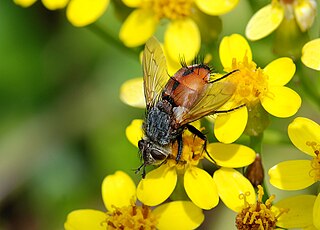
Bandwings, or band-winged grasshoppers, are the subfamily Oedipodinae of grasshoppers classified under the family Acrididae. They have a worldwide distribution and were originally elevated to full family status as the Oedipodidae. Many species primarily inhabit xeric weedy fields, and some are considered to be important locusts:

Delphacidae is a family of planthoppers containing about 2000 species, distributed worldwide. Delphacids are separated from other "hoppers" by the prominent spur on the tibia of the hindleg.

Alderflies are megalopteran insects of the family Sialidae. They are closely related to the dobsonflies and fishflies as well as to the prehistoric Euchauliodidae. All living alderflies – about 66 species all together – are part of the subfamily Sialinae, which contains between one and seven extant genera according to different scientists' views.

Tachina is a genus of large flies in the family Tachinidae. There are approximately 600 species worldwide. Most have larvae that are parasitoids of Lepidopteran caterpillars.

Paraleptophlebia is a genus of mayflies in the family Leptophlebiidae. Commonly found in North America, Britain, and parts of Western Europe.

Monoceromyia is a genus of hoverfly. Species in the genus are found in the Afrotropical, Australasian, Neotropical and Oriental regions. They are mimics of wasps and the genus is distinguished by the metapleura being widely separate behind the hind coxae. The elongated frontal base of the antenna is at least as long as the basal segment of the antenna and the second abdominal tergum is longer than wide and constricted.

Chrysoperla is a genus of common green lacewings in the neuropteran family Chrysopidae. Therein they belong to the Chrysopini, the largest tribe of subfamily Chrysopinae. Their larvae are predatory and feed on aphids, and members of this genus have been used in biological pest control.

Cryptotermes is a genus of termites in the family Kalotermitidae. It is one of the economically most significant genera of drywood termites.

Nevromus austroindicus is a species of dobsonfly found in the Western Ghats of India. It is one of two species of the family Corydalidae found in southern India, the other being Neurhermes maculifera. It was formally described in 2012 on the basis of specimens from the Karnataka Western Ghats of Kottigehara with some specimens also obtained from near Sampaje. They are closely related to species found in mainland China.

Sympherobius is a genus of brown lacewings in the family Hemerobiidae. There are at least 50 described species in Sympherobius.

Glenurus is a genus of antlions in the family Myrmeleontidae and typical of the tribe Glenurini. There are about 12 described species in Glenurus.

Lomamyia is a genus of beaded lacewings in the family Berothidae. There are about 11 described species in Lomamyia.

Hyalopsocus is a genus of common barklice in the family Psocidae. There are about six described species in Hyalopsocus.

Brachynemurus is a genus of antlions in the family Myrmeleontidae. There are at least 20 described species in Brachynemurus.

Acroneuria is a genus of common stoneflies in the family Perlidae. There are more than 30 described species in Acroneuria.

Megalomus is a genus of brown lacewings in the family Hemerobiidae. There are more than 40 described species in Megalomus.

Metylophorus is a genus of common barklice in the family Psocidae. There are at least 50 described species in Metylophorus.

Wesmaelius is a genus of net-winged insects, belonging to the family Hemerobiidae.

Mallada is a genus of lacewings belonging to the family Chrysopidae. The species of this genus are found in Africa, Southeastern Asia and Australia. The genus was first described by Longinos Navas in 1925, and by monotypy the type species is Mallada stigmatus.


















